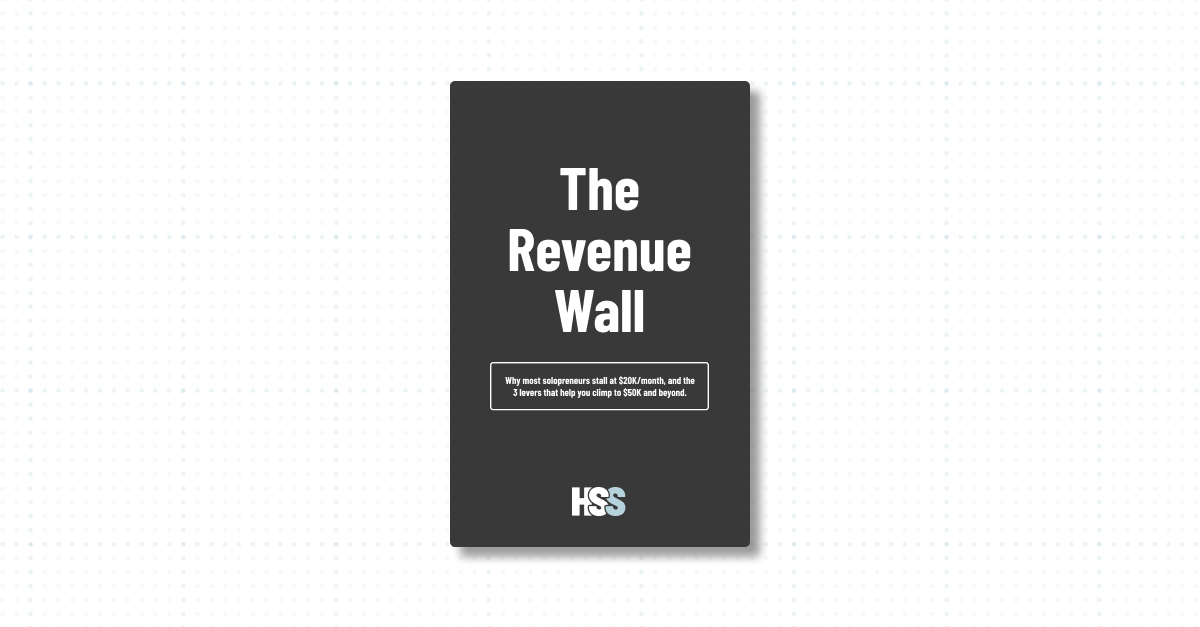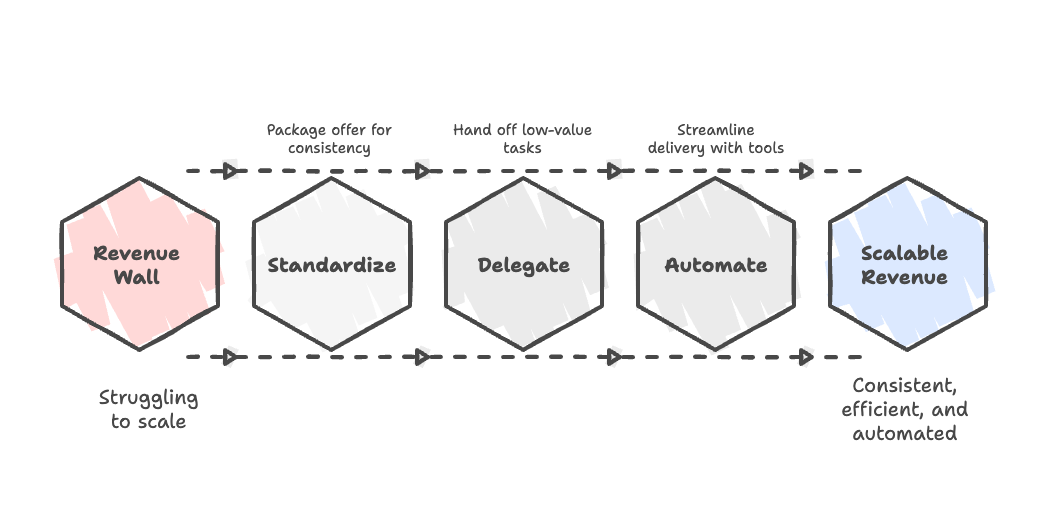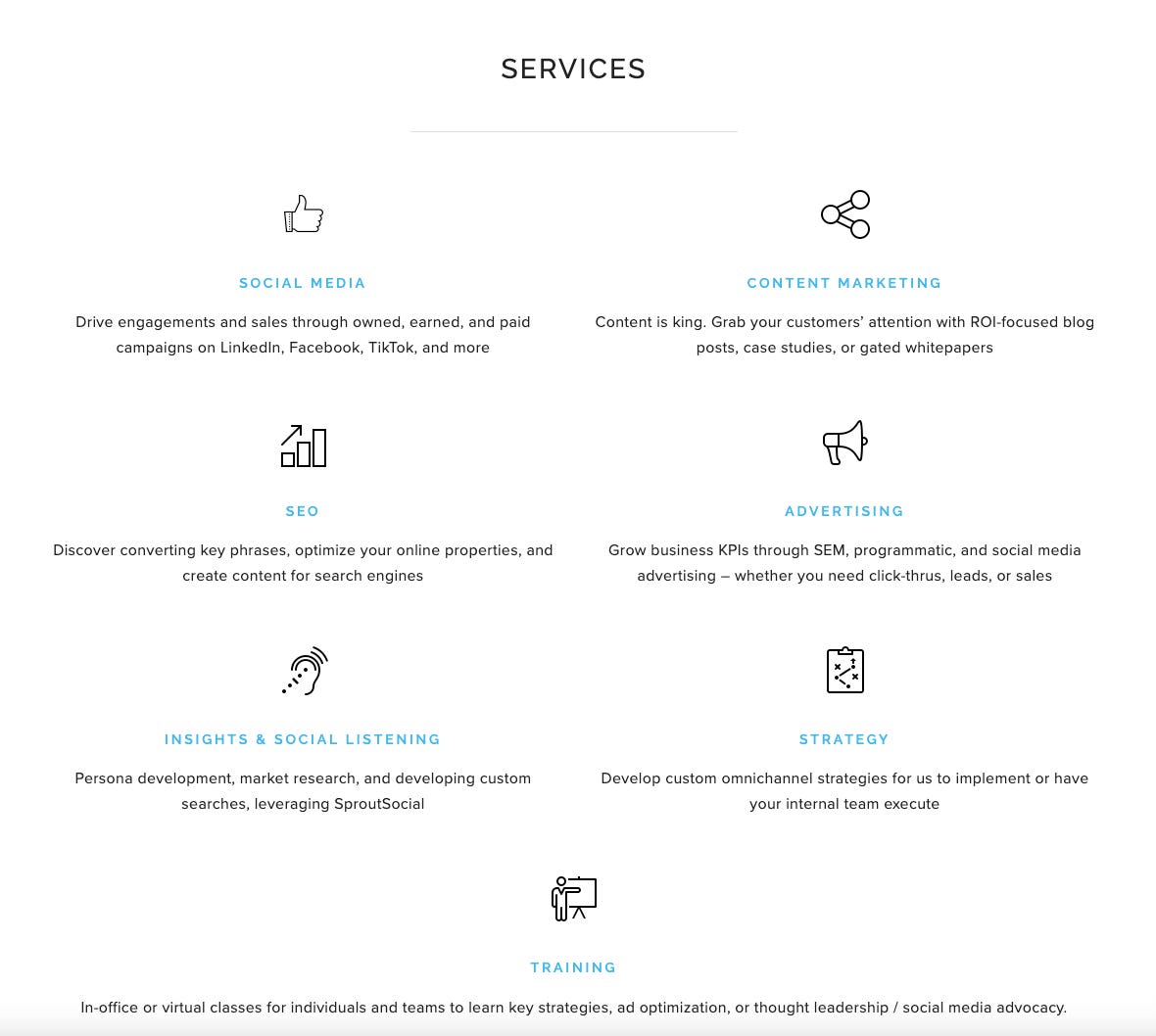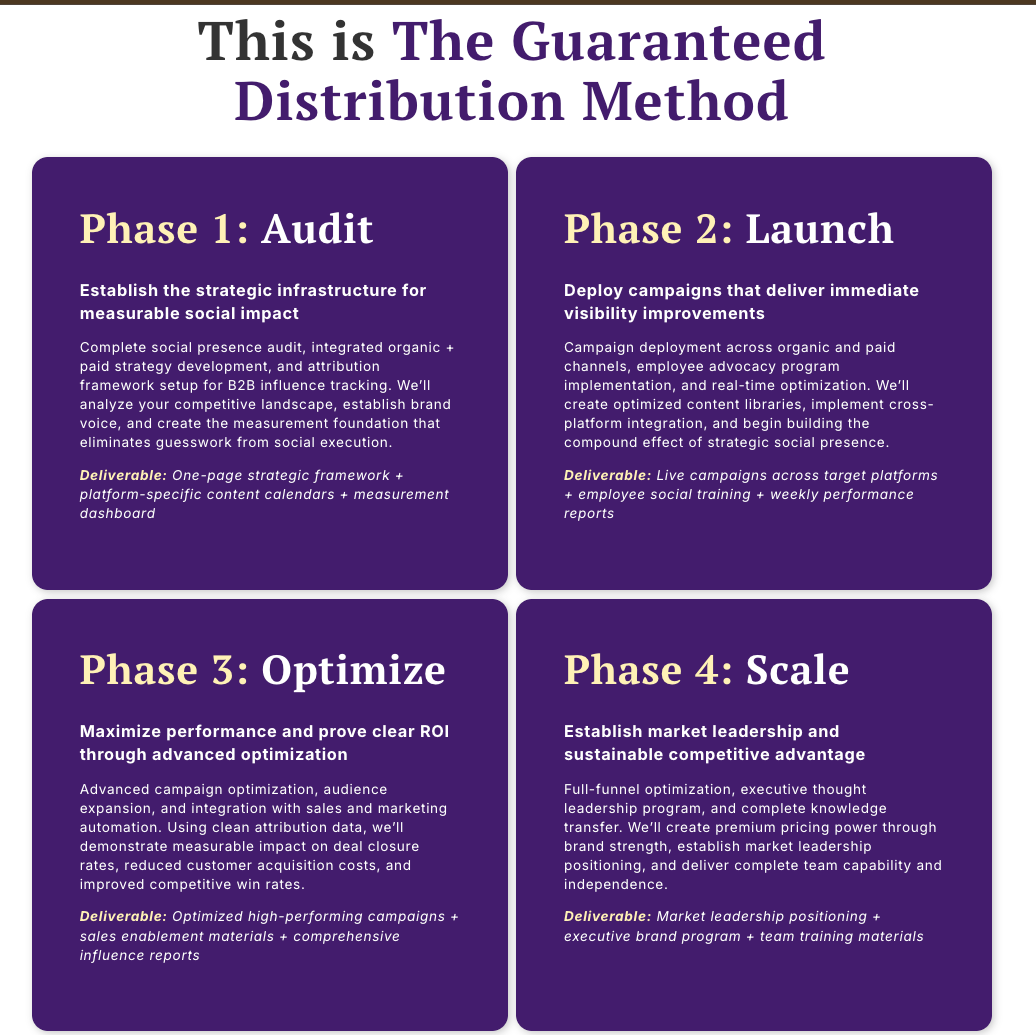The Revenue Wall: Why most solopreneurs stall at $20K/month, and the 3 levers that help you climb to $50K and beyond.
The unsexy side of building your business.
Welcome to How Solos Scale. Each week, we share a new framework, concept, or example of how solopreneurs are scaling from $25,000 to $50,000+ per month.
A quick note: This mini-book is for solopreneurs who want to scale their business beyond themselves. If you’re happy treating your solo practice like four part-time jobs, more power to you. There’s nothing wrong with that path—but you don’t need what’s in this book. The Revenue Wall only matters if you want to build a business that grows past your own capacity.
Hey there,
One of our clients, we’ll call her Sarah, is the kind of solopreneur everyone envies.
She’s magnetic, instantly trusted, and one of the most talented operators in her field. She’s closed the Recognition Gap—clients line up to work with her. At $40,000 months, she looks unstoppable from the outside.
But underneath, her business is chaos.
$28,000 in overdue invoices.
A pipeline stuffed with proposals but no way to deliver.
Three contractors on payroll, none of them operating within a clear system.
Sarah isn’t drowning because of a lack of demand. It’s because she has no system.
That’s a paradox of the scaling solopreneur journey.
Talent and charisma carry you far. But without systems, you only implode at a higher altitude.
At the start, hustle and “winging my way through it” work.
You juggle every request, customize every engagement, and rely on your brain to hold it all together. That determination can get you to $20K, even $40K monthly revenue. But at a certain point, hustle and grit stop scaling because, no matter how hard you work, there are only so many hours in a day.
You eventually find you’re not just doing the work, you’re also managing:
The process of how it gets done.
The packaging of what clients get.
The people who now depend on you (contractors, assistants, your family).
Without systems, your success makes your business more fragile, not less.
Getting clients is only half the game. Keeping your business alive once you have them is the other half. Every new client increases the chaos. Every new win adds more weight to carry. And what looked like momentum starts feeling like a slow-motion stall.
This is where you hit the Revenue Wall.
The Revenue Wall is the invisible financial ceiling you slam into once you outgrow hustle.
Every solo runs into it, and it’s impossible to avoid.
It’s the point where you’ve got more demand than you can handle, your calendar is bursting, and every new client feels like one more rock on your back.
But here’s what’s important to understand: hitting the Revenue Wall doesn’t mean you have to climb it.
Some solos look up when they hit $20K or $25K months and realize, “I’d like to make more, but not if it means giving up my life. This is enough.” They value their kids, their time, or their sanity too much to keep forcing more revenue. They pause by choice.
And you know what? That’s success. That’s winning.
But if you do want to climb it, we see solos get stuck in one (or both) of these places:
You white-knuckle it. You grind through the pain to slowly climb the wall. You stack nights and weekends and push to $40K–$50K/month. On paper, you’re crushing it. But ask them how it’s going, and they’re miserable.
Instead of saying “I want to grow,” they show up to us saying, “I just want my life back.”
You hit a mindset wall. You look at your workload, your health, your exhaustion, and say: “I can’t imagine how this could keep growing.” You want more revenue, but you don’t have enough mental stamina left to think about how to get it.
You plateau not because you can’t grow, but because you can’t picture a way to grow without self-destruction.
Both paths lead to the same place: burnout, resentment, and the slow death of the work you once loved.
This is why people who scale to $40K or $50K months are not better than people who call for help at $25K. If anything, they’re often worse off.
If most of what you’re doing feels like an obligation, the Revenue Wall is going to feel impossible. But when you’re working from inspiration, even if the hours are long, you’ll have more resilience to climb.
That’s why the most important part of scaling involves designing your business with intention — so you spend more time inspired by the work, not crushed by obligation.
Until you learn to climb The Revenue Wall—with systems, not hustle—you stay stuck.
This requires an identity shift.
You start to climb the Revenue Wall by changing your role.
Up until now, your identity has been ‘doer of the work.’ Every client, every deliverable, every detail has lived on your shoulders. That’s what got you to $20K, even $50K. But at the Wall, doing all the work won’t move you forward. In fact, it makes things worse. The more you carry, the heavier every new client feels.
This means you have to make a fundamental shift in your job description.
You stop being the person who does all the work. You start being the person who designs the system that does the work.
Growth beyond the Revenue Wall is about creating more capacity. But capacity doesn’t come from working more hours or saying yes to every project.
It comes from systems.
The 3 System Levers To Scale The Revenue Wall
The solos who climb the Revenue Wall pull three levers:
Standardize – Stop reinventing the wheel. Clarify and package your offer so every client gets the same scope of work, delivered through a process you can refine over time.
Delegate – Hand off the high-frequency, low-value tasks that drain your energy. Find an integrator who manages the projects and players so you can focus on the work only you can do.
Automate – Use tools and systems to remove friction, streamline delivery, and create capacity without adding more hours.
We discovered these levers the hard way, by slamming into the Revenue Wall ourselves. Nick slowly reworked his own system for months before landing on the solution we’re about to share. Erica adopted a standard process after seeing how much easier it was to sell a service (she literally closed 8 deals in a week). We’ve seen it work for ourselves and for client after client.
That’s because systems transform a solo practice from feeling like you have multiple part-time jobs into a sustainable business by 1) giving you back your time, 2) protecting you from burnout, and 3) allowing you to scale without compromising yourself.
The Revenue Wall isn’t the end of growth—it’s the moment that forces you to grow differently.
Once you stop doing everything yourself and pull these levers, the Wall transforms from a ceiling into a turning point. You stop being the bottleneck and start scaling your business.
Here’s how.
1. Standardize
The first lever is always standardization.
Standardization means turning the way you deliver into a consistent offer, with a clear process and predictable, reliable outcomes.
Most offers live at opposite ends of a spectrum.
On one end, you have productization. These are fixed packages with non-negotiable deliverables and a rigid timeframe.
On the other end, you have customization. Here, everything is bespoke. Every proposal starts as a blank page. There’s no end date, so the project carries on until you reach some sort of inevitable end.
Standardization lives in the middle of the spectrum. Think of it as the Goldilocks zone of service delivery. It’s not the chaotic mess of fully custom work, and it’s not the rigid assembly line of full productization.
To be clear, this isn’t a battle between projects and retainers. You can have standardized retainers with ongoing deliverables. Or you can have standardized projects that follow the same arc every time.
We’re biased towards standardization because it allows you to transition from juggling multiple part-time, fractional jobs (customization) or the hustle of getting 5-10 new clients a month (productization), to building a sustainable business that aligns with your energy.
When you standardize, every client engagement looks the same at the top level, even if the details vary. You become efficient because your team (or future team) knows the playbook. Your messaging is clear because you consistently sell the same structure.
Every professional service, whether you realize it or not, has a standardized system for its core business functions. The most successful companies simply make it explicit.
That’s why at Duo, we help every solopreneur standardize three things:
Engagement model — how you map out the major milestones of your service.
Communication and messaging — how you explain the problem, the POV, and the solution so every channel says the same thing.
Sales process — the conversations, follow-ups, and proposals that move buyers from “I’m interested” to “When can we start?”
Once these are standardized, everything else (content that drives the Recognition Engine, your website, and delivery) gets easier, because you’re saying the same thing, the same way, every time.
When working with clients, we use a four-phase framework because most services naturally follow this arc, and buyers intuitively understand it.
It gives you the most flexibility with the most amount of structure:
Audit – Assess the situation, uncover the gaps, and create a plan. (This can be peeled off and sold as a Sprint or activation to de-risk the bigger engagement.)
Implement – Do the work you planned. Execute, build, deliver.
Optimize – Refine and improve what’s working, cut what’s not, and build confidence in the system.
Scale – Double down on what works, expand capacity, and create new opportunities for growth.
Buyers immediately understand the logic when you describe your work this way. They stop seeing you as a hired pair of hands and start seeing you as a trusted system-builder. More importantly, you stop drowning in chaos.
Take Tom, a client who runs Sticky Tactics, who came to us when he was struggling to standardize his offer.
Tom used to scope every project from scratch: different deliverables, different timelines, different outcomes. Clients felt the inconsistency.
Here’s his original offer:
Besides his custom offer problems, his referral process had completely stopped working, cold outreach tactics felt terrible to execute, and he had no predictable way to reach the right prospects.
He reached a point where he was relying on hope instead of systems. He’d hit the wall head-on.
Once we built him a standardized offer and engagement model—Audit, Launch, Optimize, Scale—buyers no longer had to guess what they’d get. They could see the journey, the deliverables, and the outcomes.
Notice how explicit this is. Buyers don’t have to guess what they’ll get. They see the journey, the deliverables, and the outcomes.
When potential buyers look at your solution, they should see:
A clear path from their current situation to their desired outcome
Specific deliverables that make your expertise concrete
Well-defined support structures that reduce their risk
Measurable outcomes that justify their investment
This isn’t designed to create rigid systems that box you in. The goal is to create enough structure to sell effectively while maintaining the flexibility to adapt to each client’s needs. Your framework will evolve as you work with more clients, but you have to start somewhere.
Without standardization, scaling is a constant struggle. With it, you build the foundation that makes the next two levers—delegation and automation—possible.
2. Delegate
Once your offer and process are standardized, the next lever is delegation.
Most solos think they’re already doing this. They hire a VA or EA, hand off their calendar, outsource some admin tasks. But delegation at this level isn’t just about buying back a few hours. It’s building capacity by creating an integrator—someone who manages the projects and the players so you don’t have to.
Here’s the distinction:
Visionary (you): Lead gen, sales, client strategy. The work only you can do.
Integrator (others): Keeps projects on track, makes sure people get paid, and holds everyone (contractors, clients, even you) accountable.
Think about Sarah again. At $40,000 months, she had technically delegated tasks to the three people working for her. But she handed off the wrong things. Instead of giving them clear, repeatable tasks inside a system, she asked them to run point on a big client contract and the strategy behind it. Without a standard structure, the team was set up to fail. The engagement fell apart.
Most solos either delegate too early (before they’ve standardized anything) or they delegate the wrong things (low-frequency, high-value strategy only they should be doing).
The rule of thumb?
Delegate the high-frequency, low-value, energy-draining tasks first.
These are the things that drain your energy but don’t require your expertise. They’re repetitive, predictable, and safe to hand off once you’ve created the process.
Inbox and scheduling
Meeting prep and follow-up
Data entry and reporting
Client accountability tasks that don’t require your brain
Done right, delegation unlocks leverage. It frees you to focus on growth activities—sales conversations, client strategy, thought leadership—that move the business forward.
Done wrong, delegation creates more chaos.
You burn money, stall projects, and frustrate clients.
This is why standardization is the first priority. Once you know what “the work” looks like, you can confidently hand it to someone else. But delegation isn’t about hiring an army. Delegation is deciding whether a task goes to a person or a robot.
Most solos at this stage bring on part-time contractors or a single integrator. You don’t need a W-2 payroll to scale past the Revenue Wall. You just need to stop trying to be both the visionary and the integrator at the same time.
There’s one more nuance here: how you delegate.
Some solos hire one person to manage everything for one client (vertical integration). Others hire specialists who each handle the same type of task across all clients (horizontal integration).
We see the majority of success with horizontal integration. It derisks your hires and mirrors how most people already operate. Most people aren’t good at everything it takes to manage a client, but they’re great at one or two things. Instead of expecting one person to handle the full client relationship, you want to build a lightweight team of specialists who each handle a slice of the work they’re best at. This creates consistency across clients, makes turnover less painful, and gives you leverage without complexity.
When you begin delegating, you’ll realize not everything needs a person. Some tasks are better run by systems.
That’s where the third lever comes in.
3. Automate
Automation almost always runs in tandem with delegation.
Once you’ve standardized your offer and process, you start seeing all the repetitive, low-value tasks that eat your time. Some of them are best handed off to an integrator or assistant. Others are better handled by systems and tools.
Automation isn’t a separate step as much as it is a parallel lever.
The trick to scaling is doing both at once.
Delegation gives you people leverage.
Automation gives you systems leverage.
Together, they free you from being the bottleneck.
But you might not need automation right now.
Automation only makes sense once frequency tips the scale.
Take our client onboarding process at Duo.
In the beginning, Nick manually managed every step—from intake forms to kickoff calls to project setup. It worked, but it was slow. At this stage, we didn’t need to hire full-time ops teams. But we did need help from someone who specializes in building systems.
That’s when Maggie came in. Maggie is an operations consultant who installs project management systems (she prefers ClickUp) and automates workflows. She doesn’t replace your integrator, but she builds the infrastructure that makes your integrator effective.
When Maggie started working with us, she took tasks off our plate by automating the entire onboarding process. What used to take two hours now takes two minutes.
(And now she does the same thing for most of our clients because she’s a trusted partner.)
That wasn’t delegation or automation. It was both, in tandem.
The tipping point for automation is when the frequency of a task creates bottlenecks.
If you only add one or two clients a year, systemization at this level doesn’t make sense. But if you’re onboarding one or two a month, automation is the difference between growth and burnout.
You can see how this plays out with one of our clients, Brian.
Brian’s business hit the Revenue Wall at $50,000 a month. He had already standardized his offer and brought on contractors, but he was still the one bottlenecking delivery. Maggie installed a project management system that automated task assignments, reviews, and approvals across multiple contractors. That one move doubled Brian’s capacity and helped unlock his path to $100,000 months.
You also want to consider your value and energy.
Value: Does the task create value for you or your clients? Client strategy creates value. Manaing your own bookkeeping doesn’t. Marketing and sales create value. Most admin doesn’t.
Energy: Does it give you energy or drain it? If you love doing your bookkeeping (rare, but possible), keep it. If it drains you and it’s not creating value, get it off your plate.
Skill: Is it in your zone of genius? Just because you can force yourself to do QuickBooks doesn’t mean you should. Sarah hated bookkeeping, was bad at it, and refused to let it go—and it became a growth bottleneck.
How we see it:
If a task is high value (like client strategy) and it gives you energy, keep it.
If a task is high value but drains you (like bookkeeping), look for ways to delegate it.
If a task is low value and high frequency, automate it.
If a task is low value and low frequency, delegate it to someone who thrives there.
If you love it, keep it. If you don’t, get it off your plate.
The goal of automation is to build systems that run without you.
Automated onboarding surveys so every client starts the same way. Automated task routing so contractors know exactly what to do next. Automated follow-ups so clients stay informed without you needing to write every email.
Just like with delegation, the danger is skipping steps. If you try to automate chaos, you just make the chaos faster. That’s why standardization comes first. Because it gives you the clarity to know what’s worth automating and what still needs a human touch.
At this stage, most solos don’t build out entire ops teams. They work with a contractor like Maggie or a solo operations pro who can design and install these systems alongside their integrator. The result is transformative.
Workflows stop depending on your memory. Clients stop depending on your inbox. Growth stops depending on your hours.
When standardization, delegation, and automation run together, your business begins to scale.
That’s the moment you know you’re climbing the Revenue Wall instead of crashing against it.
If you’re up against the Revenue Wall, know it’s not a personal failure. It’s not a sign that you’re bad at business or that you’ve maxed out your potential. It’s a natural block. Every solopreneur who grows past $20K eventually slams into it.
Now you know it’s the point where your job changes. Where doing more of the same no longer works. The way through is always the same:
Standardize the work so every engagement takes the same shape.
Delegate the right things so you stop being the bottleneck.
Automate the rest so the system runs without you.
Like we said at the beginning, many solos come to us saying, “I don’t want more money. I just want my life back.” The irony is that when you climb the Revenue Wall the right way, you get both.
The business you built finally stops running on you and starts running because of you.
Cheers,
Nick, Erica, & Katrina
PS: Ready to standardize your custom consulting services? Book a call with Nick and Erica.
Have questions? Ask us in a comment below.








